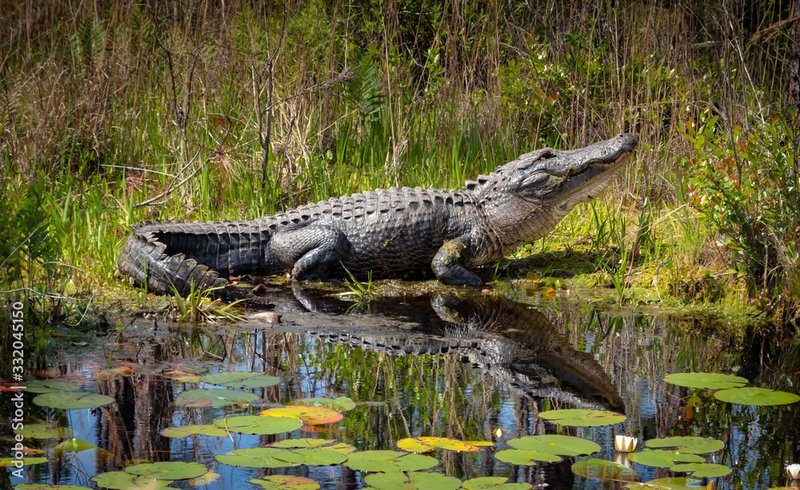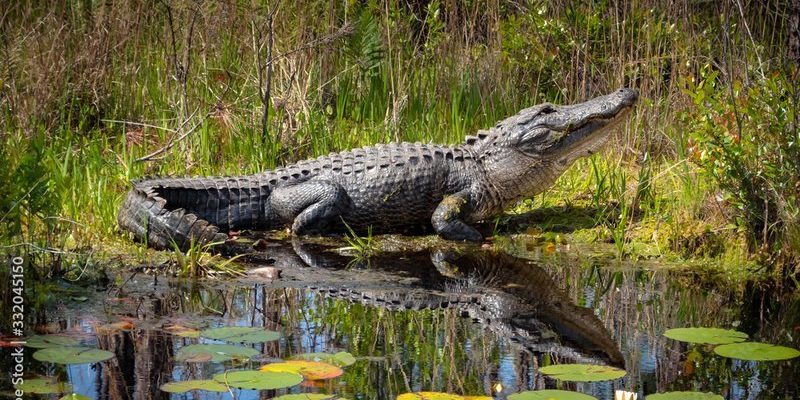
The American alligator is a fascinating creature that often captures our imagination. Residing primarily in the southeastern United States, these large reptiles play a vital role in their ecosystems. They are part of the ecosystem’s health, influencing fish populations and wetland habitats. Learning about the American alligator isn’t just about understanding a single animal; it’s about appreciating a key player in the natural world.
You might think of alligators as fearsome predators lurking in the swamp, but there’s so much more to their story. They are social, engaging creatures that display complex behaviors and intriguing adaptations. From their powerful jaws to their remarkable ability to blend into their surroundings, the American alligator offers us both wonder and respect for wildlife.
This article dives into the life of the American alligator, exploring its characteristics, habitat, diet, and the role it plays in the ecosystem. Plus, we’ll tackle some common questions about these remarkable reptiles that will leave you with a deeper appreciation for their existence.
Physical Characteristics
The American alligator is not just big; it’s impressive in many ways! Adult alligators can grow up to 13 feet long, although most are smaller, averaging around 9 to 10 feet. Their powerful bodies are covered in tough, scaly skin, which can help them withstand both the elements and potential predators. The coloration typically consists of dark green to gray hues, allowing them to blend seamlessly with riverbanks and swamps. This camouflage is essential for both hunting and avoiding threats.
What’s even more captivating is their jaw structure. An alligator’s jaw can exert a staggering amount of pressure—estimated to be over 2,000 pounds per square inch! This formidable force makes them effective hunters, capable of snapping up fish, birds, and even larger mammals. Despite their fearsome reputation, alligators have a key adaptation: their eyes and nostrils are positioned on the top of their heads, allowing them to remain mostly submerged while keeping an eye on their surroundings.
Interestingly, their bodies are designed for both water and land. The webbed feet help them swim efficiently, while their powerful tails serve as rudders, steering them through the water. On land, they can lumber along in a surprising display of speed, sprinting short distances when necessary. Understanding these physical traits helps us appreciate how well-adapted the American alligator is to its environment.
Habitat and Distribution
The American alligator primarily inhabits freshwater environments, such as swamps, marshes, lakes, and rivers. They thrive in ecosystems rich in vegetation, which provides cover and a rich source of food. You can find them in places like Florida’s Everglades, Louisiana bayous, and even along the coastal wetlands of the southeastern United States. This adaptability to various freshwater habitats contributes to their widespread distribution.
They’re also known to create “alligator holes”—depressions in the wetlands that hold water during dry spells. These holes provide a crucial resource for various species, including fish, birds, and other wildlife, during times of drought. In this way, alligators help maintain the health of their ecosystems. Their presence indicates a thriving habitat, and where you find alligators, you often find a diverse array of species cohabitating.
As human activities encroach upon natural habitats, American alligators face threats from habitat loss. Urban development, pollution, and climate change have begun to impact their populations. It’s essential to conserve and protect these wetlands to ensure that alligators—and the ecosystems they support—can continue to flourish.
Diet and Hunting Behavior
The American alligator is a carnivore, feasting mainly on fish, amphibians, reptiles, and small mammals. They have a diverse diet, which allows them to adapt to seasonal changes in food availability. Their hunting method is a combination of stealth and power. They often wait patiently near the water’s edge, camouflaged by their surroundings, and launch a sudden attack when prey comes too close.
Young alligators typically consume smaller prey, such as insects and small fish, while adults can tackle larger animals, including deer or livestock if the opportunity arises. They don’t need to eat every day; they can go for weeks or even months without food, especially during colder months when their metabolism slows down. This makes them resilient hunters in fluctuating environments.
One interesting behavior is their use of “bellowing.” During mating season, males will produce low-frequency sounds that can travel long distances, attracting females and establishing their territory. This vocalization showcases the social aspect of alligator life, reminding us that these reptiles are not just solitary hunters but also complex creatures with social interactions.
Reproduction and Lifecycle
When it comes to reproduction, American alligators are quite fascinating. The mating season occurs in late spring, and males will court females with bellowing noises and displays of strength. After mating, a female will build a nest from vegetation and mud, typically laying around 30 to 50 eggs. She carefully guards this nest, fiercely protecting it from potential threats.
After approximately 65 days, the eggs hatch, and the mother will help guide the young hatchlings to the water. Interestingly, the temperature of the nest determines the sex of the hatchlings; warmer nests tend to produce males, while cooler ones produce females. This unique trait highlights the intricate connections between the environment and the animals within it.
Once hatched, baby alligators are about 6 to 8 inches long and are vulnerable to various predators, including birds, snakes, and larger fish. The mother stays close to protect her young for the first year or so, showing a nurturing side not often associated with reptiles. As they grow, they gradually become more independent, eventually reaching maturity at around 6-10 years of age, depending on environmental conditions and food availability.
Conservation Status
Once on the brink of extinction due to overhunting and habitat loss, the American alligator has made a remarkable recovery. Thanks to conservation efforts and legal protection, they are no longer listed as endangered. This comeback story serves as a powerful reminder of the importance of wildlife conservation. Their populations are now stable, and they can be found in abundance throughout their natural ecosystems.
However, challenges still exist. Human-wildlife conflict is a reality, as alligators sometimes venture into populated areas, leading to fears and misunderstandings. Education is vital in helping communities coexist with these majestic creatures. Programs that inform the public about the American alligator’s role in the ecosystem and safety guidelines for living near their habitats can make a significant difference.
Another threat is climate change, which affects habitat quality and availability. Rising temperatures and sea levels can alter the delicate balance of the wetlands that sustain them. Continued commitment to conservation efforts, habitat protection, and public education is crucial to ensuring that future generations can enjoy and admire the American alligator in its natural habitat.
Interesting Facts about the American Alligator
| Scientific Name: | Alligator mississippiensis |
| Size: | Up to 13 feet |
| Weight: | Up to 1,000 pounds |
| Habitat: | Freshwater rivers, swamps, and marshes |
| Diet: | Carnivorous (fish, birds, mammals) |
| Lifespan: | 35-50 years in the wild |
| Speed: | Up to 20 mph in short bursts |
FAQ
What do American alligators eat?
American alligators are primarily carnivores. Their diet consists mainly of fish, amphibians, birds, and small mammals. They are opportunistic feeders, which means they will adjust their diet based on the availability of prey. While young alligators eat insects and small fish, adults can take down larger animals such as deer or livestock when needed. Their ability to go weeks without food also helps them survive in fluctuating conditions.
Where do American alligators live?
American alligators thrive in freshwater habitats, including swamps, marshes, lakes, and rivers. They are most commonly found in the southeastern United States, particularly in Florida and Louisiana. Their habitats are rich in vegetation, providing cover and ample food sources. Unfortunately, these environments are increasingly threatened by urban development and pollution, making habitat conservation crucial for their survival.
How fast can an American alligator swim?
American alligators are surprisingly swift swimmers, capable of reaching speeds of up to 20 mph in short bursts. Their streamlined bodies and powerful tails help them navigate through the water efficiently. Despite their bulk, they can quickly propel themselves, particularly when hunting or escaping danger. This speed, combined with their excellent camouflage, makes them effective predators in their aquatic environments.
Are American alligators dangerous to humans?
While American alligators are formidable predators, they generally avoid human interaction. However, they can pose a danger if provoked or if humans venture too close to their nests or young. It’s essential to respect their space and observe them from a safe distance. Understanding their habitat and behavior helps minimize the risk of conflict. Education about alligator safety can go a long way in ensuring harmonious coexistence.
How long do American alligators live?
In the wild, American alligators can live between 35 to 50 years, depending on environmental factors and threats they face. Factors such as food availability, habitat quality, and human impact can influence their lifespan. In captivity, they may live longer due to regular food supply and lack of predators. This long lifespan allows alligators to play essential roles in their ecosystems for many years.
Can alligators climb trees?
Yes, alligators are surprising climbers! While they are more known for their swimming abilities, they can climb low trees and bushes, especially if they are young and smaller. This behavior can be beneficial for basking in the sun or avoiding larger predators. However, adult alligators are not typically tree climbers, as their size and weight make it more challenging.
What is the difference between an alligator and a crocodile?
Crocodiles and alligators may seem similar at first glance, but there are key differences. Typically, alligators have a broader snout and are darker in color than crocodiles. Additionally, alligators prefer freshwater habitats, while crocodiles can often be found in saltwater. Their behavior also differs; alligators tend to be more aggressive than crocodiles when threatened. Both species play unique roles in their respective ecosystems.
Do alligators hibernate?
Alligators do not hibernate in the traditional sense, but they do enter a state of brumation during colder months. This means their metabolism slows down significantly, and they become less active. In colder temperatures, alligators may remain submerged in water, with only their nostrils above the surface, seeking refuge from freezing conditions. This winter adaptation helps them survive harsh environments.
Why are American alligators important to their ecosystems?
American alligators are considered “keystone species,” meaning they have a profound impact on their ecosystems. By creating alligator holes, they maintain wetland habitats, providing essential resources for various species during dry periods. Furthermore, their predatory behavior helps regulate fish and other animal populations, contributing to the overall health of aquatic systems. Protecting alligators ensures the balance of the environments they inhabit.

